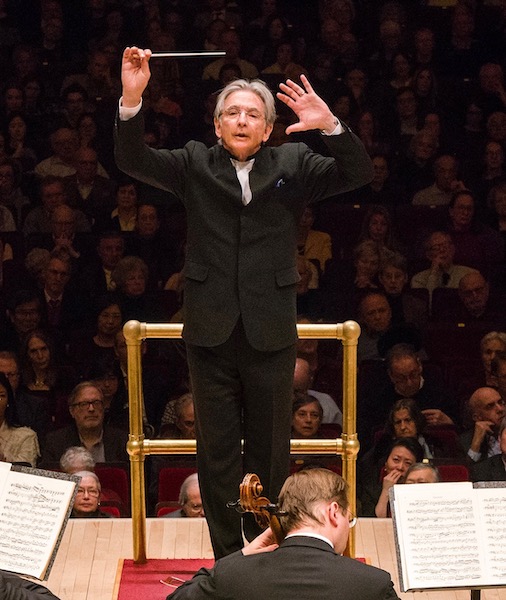Tilson Thomas, Vienna Philharmonic deliver a seasoned, affecting Mahler Ninth

Michael Tilson Thomas conducted the Vienna Philharmonic Orchestra in Mahler’s Symphony No. 9 Wednesday night at Carnegie Hall. Photo: Richard Termine
Mahler’s Ninth Symphony has been no stranger to New York recently. Between the Philharmonic and visiting orchestras, every concert season seems to bring another opportunity to encounter this challenging yet elusive work.
But no orchestra and conductor have come to town with shinier Mahler credentials than the Vienna Philharmonic Orchestra and Michael Tilson Thomas, who joined forces in a memorable performance of the Ninth at Carnegie Hall Wednesday night.
The Vienna Philharmonic gave the Ninth its world premiere in 1912 under Bruno Walter. Conductor Tilson Thomas has few, if any, peers as an interpreter of Mahler’s music, both in performance and in talks and videos. To describe their collaboration on Wednesday as “lived in” would be an understatement.
Indeed, any truly successful Mahler performance requires a sense of where the work stands in relation to the rest of the composer’s work. The sequence of nine symphonies and Das Lied von der Erde has been described as a single, evolving work, in which the composer returned again and again to his core ideas—the beauty of the world and its flip side, the inevitability of death—and widened his perspective each time.
The basic challenge of the Ninth is to achieve that widened perspective within a reduced palette. Gone are the choruses, the soloists, the poetic texts, the five or six movements Mahler wielded in his earlier symphonies. The piece’s purely orchestral medium, and its four-movement form with weighty outer movements and diversions in the middle, would have been familiar to Haydn or Mozart.
That said, performers of the Ninth must unlearn everything they know about continuity of expression, smooth transitions, and tonal blend—quite a lift for Wednesday’s orchestra and conductor, who are noted for exactly those things. Interpreting a score studded with German adjectives that translate as “awkward,” “rough” and “truculent,” the Vienna players had to cultivate their famously polished phrasing as well as be ready to contradict it (as Mahler indicated) “with the greatest violence.”
To mock a tender scene with a trombone blast isn’t hard in itself. The larger achievement of Wednesday’s performance was integrating such elements in a higher continuity, a “sym-phony,” literally a sounding together. Steering a course between glibness and outright anarchy, Thomas and the orchestra expressed Mahler’s most modern sensibility: the imperative to keep moving forward while holding contradictory ideas simultaneously in the mind.
The symphony’s first movement expressed this psychic state most overtly, rising from pianissimo in gentle waves of string tone. Given the evident care taken over every bar of this performance, one had to conclude that the horns’ loud intrusions on the string line—which would be considered a flaw in a performance of, say, Brahms—were here a foretaste of more dramatic interruptions to come.
And come they did, “like new eruptions of a volcano,” as Alban Berg described them. It was an apt metaphor for the sensations of both violence and flow that this performance evoked. But however huge the eruptions, the essential intimacy and inwardness of the movement were reaffirmed as the texture thinned to nothingness at the end.
As a delicately-executed trill motive danced alongside rude squeaks and honks, the second movement, a kind of country-style waltz (ländler), walked a fine line between symphony and vaudeville. Wind solos sparkled and tempos shifted expertly into high gear, but the point of this long movement—irony? nostalgia? love of humanity?—remained unclear in Wednesday’s performance.
Not so with the following Rondo-Burlesque, which had a bitter tang from bar 1. In a fast but not hectic tempo, light but mordant strings glinted with woodwind highlights. Dissonances piled high as the devilish scherzo drove ahead, with no loss in the transparency of the orchestral texture. The slower middle section, however, was all blend and swell, a fervent entreaty for mercy enhanced by comforting harps but mocked by acidic winds. Lightning flashes of brass and woodwinds lit up the long accelerando to the sudden, harsh finish.
The assurance of Tilson Thomas and the Philharmonic in this symphony and its message was abundantly evident as the endless string melody of the last movement climbed in great broad curves, then yielded to page after page of taut pianissimo under concertmaster Reiner Honeck’s searching violin solo.
Dissonance became not a disruptive force but a partner in the symphonic idiom, an intensifier of crescendos. In the movement’s second long climb, every modulation marked another stage reached, the sound environment developing from wispy to sensuous to robust as the composer sought new sound chemistry to express new inner states.
In the end, however, composer and performers reluctantly let it all go, in many pages of breath-holding pianissimo, diminuendo, to silence. The Carnegie audience seemed even to applaud reluctantly at first—but then loud and long, on its feet.
Carnegie Hall presents the Philadelphia Orchestra conducted by Yannick Nézet-Séguin with pianist Jan Lisiecki in works of Nico Muhly, Mendelssohn, and Schubert 8 p.m. Thursday. carnegiehall.org; 212-247-7800.